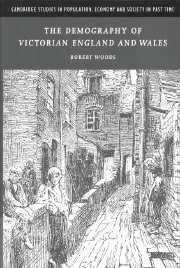Book contents
- Frontmatter
- Contents
- List of figures
- List of tables
- Preface
- 1 Bricks without straw, bones without flesh
- 2 Vital statistics
- 3 Whatever happened to the preventive check?
- 4 Family limitation
- 5 The laws of vitality
- 6 Mortality by occupation and social group
- 7 The origins of the secular decline of childhood mortality
- 8 Places and causes
- 9 The demographic consequences of urbanisation
- 10 The transformation of the English and other demographic regimes
- 11 Conclusions and unresolved conundrums
- Bibliography
- Index
- Cambridge Studies in Population, Economy and Society in Past Time
6 - Mortality by occupation and social group
Published online by Cambridge University Press: 07 August 2009
- Frontmatter
- Contents
- List of figures
- List of tables
- Preface
- 1 Bricks without straw, bones without flesh
- 2 Vital statistics
- 3 Whatever happened to the preventive check?
- 4 Family limitation
- 5 The laws of vitality
- 6 Mortality by occupation and social group
- 7 The origins of the secular decline of childhood mortality
- 8 Places and causes
- 9 The demographic consequences of urbanisation
- 10 The transformation of the English and other demographic regimes
- 11 Conclusions and unresolved conundrums
- Bibliography
- Index
- Cambridge Studies in Population, Economy and Society in Past Time
Summary
Independently of the influence of the material and of the work itself on health, the place in which men work exercises so great an influence that it has to be taken into account in judging of the salubrity of their occupations.
Mortality may be said to depend upon two factors, the man himself and his circumstances or environment, including his occupation.
Even now there exists a discernible mortality gradient between social groups defined by combinations of occupations in terms of some preconceived status hierarchy. It is a commonplace that income, education and housing quality are linked in a self-reinforcing fashion; and that poor diet and heavy smoking and drinking are in broad terms also connected. There exists today a ‘trailing class’ – one made up from the most vulnerable, the least healthy, the most prone to long-term unemployment and the one whose members have the lowest life chances. Among the other social classes there are some signs that, in the late twentieth century, convergence accompanied the steady rise in life expectancy. Occupation, and thus social class, is but a mirror to wealth and habit; work itself is likely to be more or less dangerous, but the labour market acts as both a sieve and a social labelling device.
Prompted by the Black Report of 1980 many recent studies have attempted to chart changing trends in the level of mortality and the extent of ill-health between sub-populations defined in terms of adult male occupations. They have encountered at least four problems.
- Type
- Chapter
- Information
- The Demography of Victorian England and Wales , pp. 203 - 246Publisher: Cambridge University PressPrint publication year: 2000



